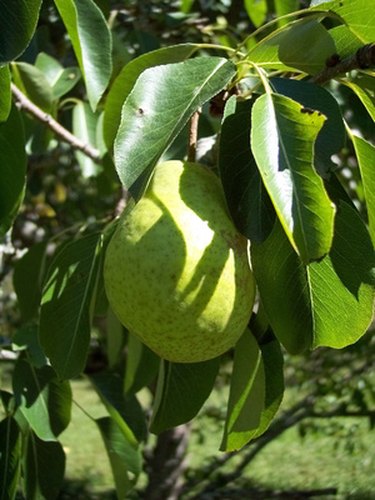
Pear trees are grown in commercial and residential landscapes throughout much of the United States for the showy clusters of white flowers they yield. Popular ornamental pear trees such as Manchurian pear trees and Bradford pear trees are being replaced by hardier varieties such as Southworth Dancer, Chanticleer and Burgundy Snow pear trees. Although popular in landscapes throughout the country, the Alabama Cooperative Extension System recommends against Bradford pear trees because they are relatively short-lived trees, often declining after just 20 years. Manchurian pear trees are being replaced by other varieties or ornamental pear trees that are stronger, according to Fleming's Nurseries.
Burgundy Snow
Video of the Day
Burgundy Snow (Pyrus calleryana) is an ornamental pear tree and a member of the Rosaceae family. This landscape plant is one of the most favored ornamental pear trees because it is one of the varieties that bears the most flowers. Burgundy Snow pear trees mature to a height of 33 feet and have a spread of almost 20 feet. Burgundy Snow has a moderate growth rate of 12 to 25 inches annually and is pyramidal in shape. The leaves of this ornamental pear tree are medium to dark green and change to a vibrant yellow and red in the fall. In the spring, this tree is covered in clear white flowers. One of the best benefits to planting the Burgundy Snow pear tree is that they are adaptable to a variety of sites, including those with slightly alkaline soils as well as those with dry soils, according to Fleming's Nurseries. For the best results, this tree should be planted where it receives full sunlight.
Video of the Day
Chanticleer Pear
The Chanticleer pear tree (Pyrus calleryana) is an ornamental, flowering pear tree that thrives in USDA Hardiness Zones 5 through 8. This plant grows well in acidic or alkaline soils, making it suitable for a wide range of areas, and it prefers locations where it receives full sunlight. The fruit produced by the Chanticleer pear tree is brown, round, and measures just 1/2 inch in diameter. From April through May, this tree yields clusters of white flowers that are each 1 inch in diameter. This variety of pear tree came to the United States from China and Korea, where they used the wood produced by the tree to make furniture, according to the Arbor Day Foundation. The Chanticleer pear matures to a height of 25 to 35 feet and a has a spread of 16 to 25 feet. This tree grows 12 to 24 inches annually.
Southworth Dancer
Southworth Dancer pear trees are growing in popularity due to the birch-like leaves that freely sway in the wind. This ornamental pear tree matures to a height of 23 feet and a width of 14 feet, making it an appropriate size for residential and commercial landscapes. This oval or pyramidal tree features silvery-gray to medium green leaves that turn yellow in the fall. In the spring, the Southworth Dancer yields an abundance of white flowers. These flowers appear in cluster of 8 to 10 flowers and are accented by purplish-red stamens. This tree is easy to grow because it is tolerant of a variety of conditions, such as dry soils, air pollution, and slightly alkaline soils.
- Fleming's Nurseries: Pyrus calleryana 'Bursnozam' Burgundy Snow
- Arbor Day Foundation: Chanticleer Pear
- Fleming's Nurseries: Pyrus betulaefolia 'Southworth' Dancer
- Alabama Cooperative Extension System: Choose Alternatives to Bradford Pear Trees, Experts Advise
- Fleming's Nurseries: Pyrus ussuriensis - Manchurian Pear